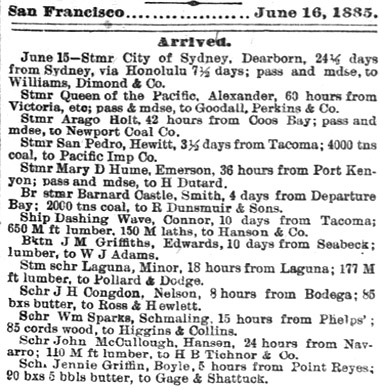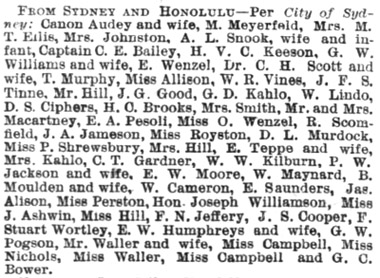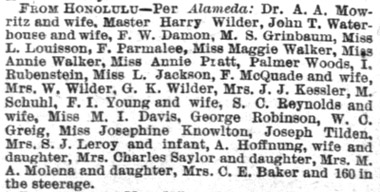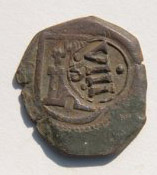Merchant Ships in Port
Please note: Merchant ship arrivals are included to give an idea of the volume and type of goods into early San Francisco. If you had the money, you could have anything your heart desired. Listings are by no means complete; names of passengers on these vessels are often unavailable.
Click here for passenger ship arrivals.
° 1846-1847 ° 1848 ° 1849 ° 1850 ° 1851 ° 1852 ° 1853 ° 1854 ° 1855 ° 1856 ° 1858 ° 1860-1862 ° 1863 ° 1864 ° 1865 ° 1868 ° 1870s ° 1880s ° 1890s
Arrivals 1880s
1883
- January 1: Daily Alta California. Just landed ex. brig Tahiti: 40,000 cocoanuts. Also desiccated cocoanuts, in bulk and fancy packages.
- February 11: Arrived: Brig Tahiti, Turner, 29 days from Tahiti. Mdse to Matthew Turner. Memoranda: Left Tahiti Jan 12 at 2:30 p.m., had 9-1/2 days light northerly winds to the equator, which was crosed in lon 146 30 W; took the NE trades strong in 2N and carriedthem to 35N, 142W; thence to port light baffling NE and N breeze. Sighted the high land of the north shore 69 miles distant. February 21: the brig Tahiti came out of Merchants Dry Dock yesterday where she had been repairing and cleaning, and docked at Mission street wharf, where she will load for Tahiti.
Tuesday, March 1, 1887, The Daily Bulletin, Hawaii: The brig Tahiti, Captain Turner, arrived in San Francisco lately, after a passage of thirty days from Tahiti. She brought up a number of passengers, among them being Captain J. T. Jensson, the carpenter, boatswain, sailmaker and two seamen of the ship Astracan, which struck on a coral-reef off Maturaivavo Island, one of the Tuamotu group, in the South Pacific, on the night of the 17th last, and became a total loss. At the time the vessel stuck a stiff breeze was blowing and one of the boats was smashed. The captain used every exertion to get the vessel off the reef, but finding it impossible, he provisioned the remaining boats and ordered all hands in and set sail for Tahiti, where he arrived nine days later. When the natives there saw the boats approaching the captain says they refused to allow the crews to pull any further, but insisted on towing the boats in, and afterward were very kind to them. The American Consul sent ten of the crew up on the schooner Greyhound, and the remainder, as stated, came up with the captain on the Tahiti. The Astracan was a bark-rigged vessel of 1,041 tons register. She was owned by Burgess & Co. of Liverpool and sailed from Astoria Novemer 16th last, wheat laden, for Queenstown for orders. Her cargo was insured in the Commercial Insurance Company for 9,000 pounds; of this amount 3,000 pounds was reinsured in the Thames and Mersey Marine Insurance Company and 3,000 pounds in other companies having agencies in this city. (San Francisco Bulletin)
- March 1: Cleared/Sailed: Brig Tahiti, Turner; Mathew Turner. Importations per Tahiti: 1642 logs and knees, 27,000 cocoanuts, 105 bags pearl shells, 2 tns vanilla, 13 cs. cocoanuts, 8 cs. coin.
- March 9: Daily Alta California. Captain Turner has launched the new schooner for Tahiti. She is named the Papeete, and is 65 feet long, 29 feet beam and 6-1/2 feet depth of hold. Her registered tonnage is 41.
- March 20: Arrived Schooner J. C. Ford, Le Ballister, 80 days from Honolulu. Rice and sugar to J. D. Spreckels & Bros.
- March 25: The barkentine Tropic Bird moved from the sea wall to Mission street yesterday, where she will load for Tahiti. Captain Burns has his vessel in vine order.
- April 7: Arrived Schooner W. H. Stevens, Hansen, 43 days from Tahiti. Mdse to A. Crawford & Co.
- May 15: Brig Tahiti, Turner, 31 days from Tahiti. Passengers and mdse to M. Turner. Memoranda: Sailed from Tahiti April 14; had light winds from NE; crosed equator 11 days out in long 150 41; took NE trades in 6 N and carried them to lat 28 N. lon 154 43 W; then had winds light and variable for 3 days; then took wind from NW to port. Consignees: A. Crawford & Co; Wilkens & Co; J. Pinkt; I. E. Thayer; Whittler, Fuller & Co; L. Blum; Martenstein & Deming; M. Turner; Order.
May 16, Daily Alta California: The brig "Tahiti" arrived from Tahiti yesterday and docked at Mision street wharf to discharge. She returns to Tahiti, sailing on June 1st. - July 28, 1883, Daily Alta California: The following passengers arrived yesterday from Tahiti per bark Paloma: T. Magee, T. Young, G. Goddeffry, Captain J. Mills, B. Noel, C. Krimphof, E. Mossen, and nine natives for the new barkentine City of Papeete.
- September 4, 1883, Daily Alta California: The brig Tahiti, Captain Turner, cleared yesterday for the Society Islands with a cargo of merchandise valued at $35,145, including 713 bbls flour, 58,722 lbs bread, 1062 mats rice, 26,694 lbs sugar, 462 de Tes, 165 c. kerosene, 148 cs canned salmon, 22 pkgs salt salmon, 12 coils rope, 57 pkgs dry goods, 437 sls beans, 138 do barley, 4 do wheat and 62 do feed. In transit - $9073, principally dry goods.
The Java Earthquake struck on August 26, 1883, beginning on the Island of Krakatoa; it then extended to every island and sea for 100 miles in either direction. This quake caused tidal waves, the first over 100 feet in height, which swept the coast of adjacent islands and the country for 500 miles, destroying every living thing in its course. Estimated deaths: 80,000 people. The brig Tahiti rescued the crew of the bark Oswingo, from Newcastle, N.S.W. for Wilmington, Cal., near Apar Island which was affected by the earthquake.
- October 25, 1883, Daily Alta California: The following passengers arrived yesterday from Tahiti on the barkentine City of Papette: J. Laharragus, Miss Pater, J. Smith and three others.

1884
July 21, 1884, Daily Alta California, San Francisco
Vessels on the Way to and Loading for San Francisco, July 21st

- August 2, 1884, Daily Alta California, San Francisco: British bark Carleton, 1299 tons, wheat to Cork, U.K.
- September 15, 1884: Daily Alta California: British Bark Carleton, Lowe, Queenstown.
1885
June 16, 1885
Too Much Opium.

The steamer City of Peking arrived from China shores yesterday afternoon with a large cargo of coolies, one of whom was dead.
An investigation by the Morgue officials proved that on the trip the dead coolie had indulged so much in smoking opium that his supply gave out.
Being unable to procure some more of the drug, he was attacked by the "habit," as it is called, which was so severe that it killed him before he could be relieved.
From the Colonies.
The War Feeling in the Colonies Strong
Career of the Forger, S. W. Green,
While in Sydney His Flight.
Among the passengers who arrived in this city on the Australian steamer City of Sydney yesterday was Mr. G. D. Kahlo, whose father for the past four years has been United States Consul at Sydney. Mr. G. D. Kahlo is a young man, not only very affable in address, but also abounding in interesting reminiscences of his sojourn in Australia. An Alta reporter, who sent up a card, was at once granted an interview by Mr. Kahlo. In response to the first query put by the reporter, Mr. Kahlo replied:
"So you want to know what I can tell you about Australian affairs, do you? Well, I'm afraid I haven't any very valuable information, but I shall be pleased to tell you whatever I can."
"I suppose, just at present,'' said the newsgatherer, "that the principle topic of interest in the colonies is the probability of an Anglo-Russian war."
WAR EXCITEMENT.
"Yes; there is no little excitement in that respect, and the British Government is now engaged in fitting up the O. and O. steamship Massalia and the Orient steamship Lusatania as cruisers, to patrol the Australian coast. There is also a very great interest taken in the militia, and, in fact, all the volunteer military organizations. On the 3d of last March, you perhaps remember, some 750 troops left Sydney for Egypt. That was one of the greatest days ever seen in Sydney. The people fairly went wild with excitement, and thousands and thousands of spectators crowded the streets all along the line of march to the transport ships. The troops consisted of 500 infantry and 250 artillerymen. Nearly all these volunteers were from the local military companies. The enthusiasm was intense, J and I think the Russian difficulty coming upon the people while yet in an excited and warlike frame of mind, there would be but one sentiment and that for war. At Melbourne for a time no strange vessel was allowed to enter the Heads between the hours of sunrise and sunset, and they enforced a similar rule at Sydney for two days, I think. Measures for defence were taken at Sydney by stretching alone: one side of the harbor a line of torpedoes. In regard to those troops which went to the Soudan, I believe they saw no fighting, and there were but two deaths among them. As to a future confederation of the colonies, I think that, judging from the tone of the prevalent sentiment, if it occurs at all, it will be in the remote future.



The Duke of Edinburgh was daily expected to arrive at Auckland from Australia, via New Caledonia, in the Galatea.
1886
- November 29: Daily Alta California. British bark Carleton, Lowe, 74 days from Sydney; 1326 tons coal, to Balfour, Guthrie & Co. Memorandum: Per Carleton - Sailed September 15; had light E NE winds to New Zealand; had light E NE winds to the Equator; crosed in lon 161.15 W October 24; from thence to port light E NE winds.
1887
December 31, 1887, Daily Alta California, San Francisco
BURNED AT SEA.
Loss of the German Bark Johanna -- The Captain's StoryThe British bark Carleton, 128 days from Maryport, arrived last night. On September 30th the Carleton picked up the captain, mate, second mate, and five seamen of the German bark Johanna, which had burned off Cape Horn. They had been afloat in a small boat for three days when rescued. Annexed is the account of the burning of the Johanna, taken from the captain's log... As the ship was on fire, they had to take to the boats at 7 p.m. On lowering the port boat, she capsized as soon as reaching the water. The next boat was lowered at 9 p.m. with seven of the crew and the cook. This being the mate's boat, the Captain asked him if he had any water on board. The mate came on board ot get some water and while he was on board the crew cut thepainter of the boat and left the ship. The Captain ordered them to come back, but they were so excited from the heat, they took no notice of the captain's order. The captin's boat left at 1:30 a.m. on the 27th, the ship being then a mass of flames. They saw nothing of the other boat after leaving the vessel. They sighted the Carleton, Captain Howe, bound for this port from Maryport, England, on October 30th. The names of the men who were in the missing boat are: Cook, E. Anderson; seamen E. Lescheck, C. Brag, A. Miller, A. Jansen, B. Behrons, E. Behahn, and one unknown. C. Burwarat, one of the crew, speaks in the highest terms of Captain Lowe and his officers. . .The list of the officers and crew picked up by the Carleton is Captain Burgwarst; First Officer Thompson; Second Officer F. Falen; Carpenter, E. Schacht; sailmaker E. Crendalh; sailors Lars, Christense, Homer, Hageen and E. Gunael.
1888
- February 2, 1888, Daily Alta California: Starr & Company have chartered the British bark Carleton, 1299 tons, to load Wheat to Cork, for orders, at 23s6d and 2s6d less if direct.
The Earl of Pembroke, who was cruising among the South Sea Islands, was wrecked. He was picked up together with the captain and crew by a passing vessel.














 Copyright ~ 1998-2017.
Copyright ~ 1998-2017.